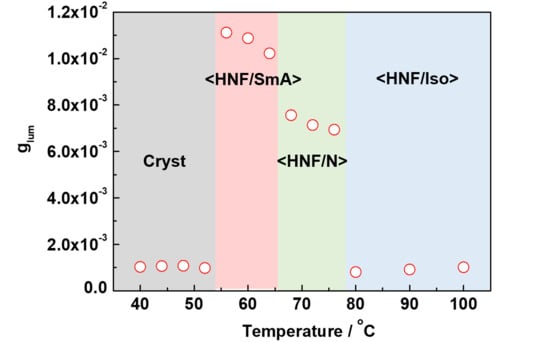Enhancement of Luminescence Dissymmetry Factor in Nano-Segregated Phase Generated by Phase Separation between Helical Nanofilaments and Liquid-Crystalline Smectic A Phase
Abstract
:1. Introduction
2. Materials and Methods
2.1. Materials
2.2. Cell Preparation
2.3. Circularly Polarized Luminescence Measurement
2.4. Polarized Emission Intensity Observations
3. Results and Discussion
4. Summary
Author Contributions
Funding
Acknowledgments
Conflicts of Interest
References
- Sang, Y.; Han, J.; Zhao, T.; Duan, P.; Liu, M. Circularly Polarized Luminescence in Nanoassemblies: Generation, Amplification, and Application. Adv. Mater. 2019, 31, 1900110. [Google Scholar] [CrossRef]
- Goto, T.; Okazaki, Y.; Ueki, M.; Kuwahara, Y.; Takafuji, M.; Oda, R.; Ihara, H. Induction of Strong and Tunable Circularly Polarized Luminescence of Nonchiral, Nonmetal, Low-Molecular-Weight Fluorophores Using Chiral Nanotemplates. Angew. Chem. Int. Ed. 2017, 56, 2989–2993. [Google Scholar] [CrossRef] [PubMed]
- Shi, Y.; Duan, P.; Huo, S.; Li, Y.; Liu, M. Endowing Perovskite Nanocrystals with Circularly Polarized Luminescence. Adv. Mater. 2018, 30, 1705011. [Google Scholar] [CrossRef] [PubMed]
- Lee, J.-J.; Kim, B.-C.; Choi, H.-J.; Bae, S.; Araoka, F.; Choi, S.-W. Inverse Helical Nanofilament Networks Serving as a Chiral Nanotemplate. ACS Nano 2020, 14, 5243–5250. [Google Scholar] [CrossRef] [PubMed]
- Jeon, S.-W.; Kim, D.-Y.; Araoka, F.; Jeong, K.-W.; Choi, S.-W. Nanosegregated Chiral Materials with Self-Assembled Hierarchical Mesophases: Effect of Thermotropic and Photoinduced Polymorphism in Rodlike Molecules. Chem. Eur. J. 2017, 23, 17794–17799. [Google Scholar] [CrossRef] [PubMed]
- Kim, K.; Kim, H.; Jo, S.-Y.; Araoka, F.; Yoon, D.K.; Choi, S.-W. Photomodulated Supramolecular Chirality in Achiral Photoresponsive Rodlike Compounds Nanosegregated from the Helical Nanofilaments of Achiral Bent-Core Molecules. ACS Appl. Mater. Interfaces 2015, 7, 22686–22691. [Google Scholar] [CrossRef] [PubMed]
- Jeon, S.-W.; Choi, H.-J.; Bae, J.-H.; Kim, B.-C.; Choi, S.-W. Photomodulating Chiroptic Behaviors in Nanosegregated Mesophase from a Mixture System Consisting of Nonchiral Bent-Core and Photo-Responsive Rod-Like Mesogens. J. Inf. Disp. 2018, 19, 129–133. [Google Scholar] [CrossRef] [Green Version]
- Park, W.; Yoon, D.K. Orientation Control of Helical Nanofilament Phase and Its Chiroptical Applications. Crystals 2020, 10, 675. [Google Scholar] [CrossRef]
- Otani, T.; Araoka, F.; Ishikawa, K.; Takezoe, H. Enhanced Optical Activity by Achiral Rod-Like Molecules Nanosegregated in the B4 Structure of Achiral Bent-Core Molecules. J. Am. Chem. Soc. 2009, 131, 12368–12372. [Google Scholar] [CrossRef] [PubMed]
- Le, K.V.; Takezoe, H.; Araoka, F. Chiral Superstructure Mesophases of Achiral Bent-Shaped Molecules—Hierarchical Chirality Amplification and Physical Properties. Adv. Mater. 2017, 29, 1602737. [Google Scholar] [CrossRef] [PubMed]
- Kim, B.-C.; Choi, H.-J.; Lee, J.-J.; Araoka, F.; Choi, S.-W. Circularly Polarized Luminescence Induced by Chiral Super Nanospaces. Adv. Funct. Mater. 2019, 29, 1903246. [Google Scholar] [CrossRef]
- Han, J.; Duan, P.; Li, X.; Liu, M. Amplification of circularly polarized luminescence through triplet–triplet annihilation-based photon upconversion. J. Am. Chem. Soc. 2017, 139, 9783–9786. [Google Scholar] [CrossRef] [PubMed]
- Takanishi, Y.; Shin, G.J.; Jung, J.C.; Choi, S.W.; Ishikawa, K.; Watanabe, J.; Takezoe, H.; Toledano, P. Observation of Very Large Chiral Domains in a Liquid Crystal Phase Formed by Mixtures of Achiral Bent-Core and Rod Molecules. J. Mater. Chem. 2005, 15, 4020–4024. [Google Scholar] [CrossRef]
- Araoka, F.; Sugiyama, G.; Ishikawa, K.; Takezoe, H. Highly Ordered Helical Nanofilament Assembly Aligned by a Nematic Director Field. Adv. Funct. Mater. 2013, 23, 2701–2707. [Google Scholar] [CrossRef]
- Riehl, J.P.; Richardson, F.S. Circularly Polarized Luminescence Spectroscopy. Chem. Rev. 1986, 86, 1–16. [Google Scholar] [CrossRef]
- Araoka, F.; Shin, K.-C.; Takanishi, Y.; Ishikawa, K.; Takezoe, H.; Zhu, Z.; Swager, T. How doping a cholesteric liquid crystal with polymeric dye improves an order parameter and makes possible low threshold lasing. J. Appl. Phys. 2003, 94, 279–283. [Google Scholar] [CrossRef]



| Materials | Phase and Phase Transition Temperatures |
|---|---|
| P-7 | Iso-170 °C-B2-155 °C-B7-144 °C-HNF |
| 8OCB | Iso-80 °C-N-67 °C-SmA-54 °C-Cryst |
| Mixture | <HNF/Iso>-80 °C-<HNF/N>-67 °C-<HNF/SmA>-54 °C-Cryst |
Publisher’s Note: MDPI stays neutral with regard to jurisdictional claims in published maps and institutional affiliations. |
© 2020 by the authors. Licensee MDPI, Basel, Switzerland. This article is an open access article distributed under the terms and conditions of the Creative Commons Attribution (CC BY) license (http://creativecommons.org/licenses/by/4.0/).
Share and Cite
Lee, J.-J.; Choi, S.-W. Enhancement of Luminescence Dissymmetry Factor in Nano-Segregated Phase Generated by Phase Separation between Helical Nanofilaments and Liquid-Crystalline Smectic A Phase. Crystals 2020, 10, 952. https://0-doi-org.brum.beds.ac.uk/10.3390/cryst10100952
Lee J-J, Choi S-W. Enhancement of Luminescence Dissymmetry Factor in Nano-Segregated Phase Generated by Phase Separation between Helical Nanofilaments and Liquid-Crystalline Smectic A Phase. Crystals. 2020; 10(10):952. https://0-doi-org.brum.beds.ac.uk/10.3390/cryst10100952
Chicago/Turabian StyleLee, Jae-Jin, and Suk-Won Choi. 2020. "Enhancement of Luminescence Dissymmetry Factor in Nano-Segregated Phase Generated by Phase Separation between Helical Nanofilaments and Liquid-Crystalline Smectic A Phase" Crystals 10, no. 10: 952. https://0-doi-org.brum.beds.ac.uk/10.3390/cryst10100952






